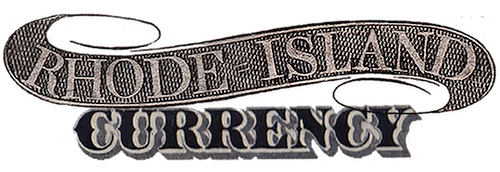National Union Bank of Woonsocket
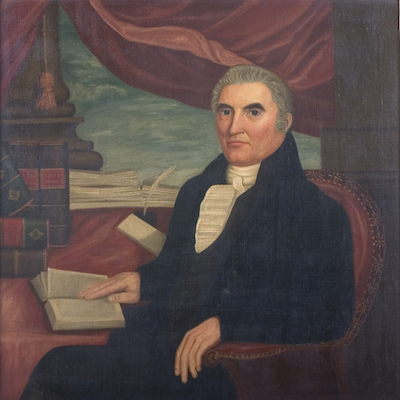
A portrait of Peleg Arnold from 1815, currently in the John Hay Library at Brown University.
On May 16, 1805, the first meeting of the directors of the Smithfield Union Bank was held in Peleg Arnold’s tavern off Great Road, in Smithfield, Rhode Island. The tavern was a popular stopover for those traveling between Providence and Worcester, Massachusetts. It also played an important role in the American Revolution as a depository of arms and center of military operations in the area.
Arnold, who founded the bank and was its first president, himself served in the war as a lieutenant-colonel. He was also a member of the Continental Congress and later, an important early figure in the abolitionist movement.
Eliab Wilkinson served as Smithfield Union’s first cashier. One biographer noted, “the bills upon this bank were never counterfeited during his term of office, his penmanship could not be imitated.” (In fact, the bank’s early bills were counterfeited.)
The bank’s first Director at Large and Auditor was Moses Brown, according to Woonsocket historian Eric Erikson. In addition to Arnold and Brown, its early directors were Stephen Whipple, Enos Mowry, Baruch Aldrich, William Buffum, Duty Winsor, Jesse Brown, Walter Allen, Thomas Mann, Simon Whipple, Thomas Aldrich, Elisha Olney and Joel Aldrich.
For the next 46 years, Smithfield Union occupied a building at the corner of Pound Hill Road and Great Road. The area of Smithfield where the bank was located came to be known as Bank Village and later this was changed to Union Village (which remains today).
The 1937 WPA Guide to Rhode Island offers these details about the early days of the bank:
“Its charter, a large lock and key, letters from Moses Brown who was a director, and other records are in the possession of the Woonsocket Trust Company.* Many of the old documents are written in ink made of nutgalls and sulphate of iron (green vitriol), which was dried by being dusted with black sand. The bank’s first cashier received $1 a day for his services. In September, 1805, Nabby Wilkinson [she was the cashier’s wife] was paid $1.75 ‘for washing and ironing’ the bank’s bills.
“The first big robbery occurred in October, 1838, when a Charles Lewis made off with $3,401. The Old Bank building, now remodeled for a dwelling house, gives little evidence of its former use. Painted a dark red, it is neat and in good repair.”
The Providence Journal filed this report about the robbery: “The Smithfield Union bank was entered, on Saturday, between the hours of 8 and 10 in the morning, and robbed of $3,100, all in the bills of bank, a portion of which can be identified. The cashier left the bank in the morning on some business; the robbers entered a vacant tenement over the bank and cut through the floor, by which means they effected a passage into the banking room, and were able to carry off the money without the trouble of forcing the vault. A reward of $500 is offered for recovery of the money and the detection of the robbers.”
It was noted that, “Smithfield Union originally incorporated for $50,000 but on August 10, 1810, before this amount had all been actually paid in, it was voted to increase the capital to $60,000. It has increased twice since that time, one February 26, 1850, to $100,000 and on March 11, 1857, to $150,000, the present amount.”
The bank’s first series of banknotes were engraved by William Hamlin in denominations of 50¢, $1, $2, $3, $5, $7, $10 and $20. Later issues included $50 and $100 notes, designed by the New England Banknote Company. Only a handful of genuine examples have survived to this day, including a unique sheet of notes that appeared in 2010 at Heritage Auctions.
The Smith-Appleby House Museum/ Historical Society of Smithfield is in possession of two banknotes and documents from this institution.
On February 17, 1852, the bank relocated to Woonsocket, as Roger Durand notes, because “it saw an opportunity for expansion as a result of the rapid expansion of the textile industry.” It occupied the Union Block, across from Woonsocket City Hall, for the next 46 years. (The building was later torn down and replaced in 1926 by the Woonsocket Institute for Savings, now 144 Main Street).
The bank was reorganized as the National Union Bank of Woonsocket in 1865 and granted charter #1409.
On May 31, 1898, the bank moved to the Buckland and Clark Building (65 Main Street) and in 1913 it relocated to the Honan Block (112-114 Main Street), which it had purchased a year earlier.
The National Union Bank of Woonsocket was liquidated on May 4, 1915 and its assets absorbed by the Woonsocket Trust Company (which had been organized April 11, 1912 and occupied the same quarters in the Honan Block). This is not unusual for the time. Several older Rhode Island banks reincorporated themselves as trust companies during this period or were bought up by the expanding Industrial Trust and Hospital Trust enterprises.
During its half century as a national bank, National Union Bank of Woonsocket issued a total of $2,213,430 in banknotes, in denominations from $1 to $100. In 1915, the year of its dissolution, $102,600 of the bank’s bills were still outstanding. According to the National Bank Note Census, 13 notes of these notes are known to be in collectors’ hands today.
The Woonsocket Trust Company was absorbed by Hospital Trust on January 2, 1952.
(One additional point of interest about the bank: In 2006, a cast-iron hand stamp from the National Union Bank sold at Skinner Auctions of Boston for $1,100.)
* It’s not known what happened to the bank artifacts mentioned here that were in the possession of the Woonsocket Trust Company over eighty years ago.
** If you have a copy of the book, One hundred and Forty Years of Banking in Woonsocket, Rhode Island, 1805-1945: An Historical Sketch of the Smithfield Union Bank and the National Union Bank, Predecessors of the Woonsocket Trust Company by Frank A Jackson (1945), please drop me a line at Collector@ricurrency.com so I can expand this page.
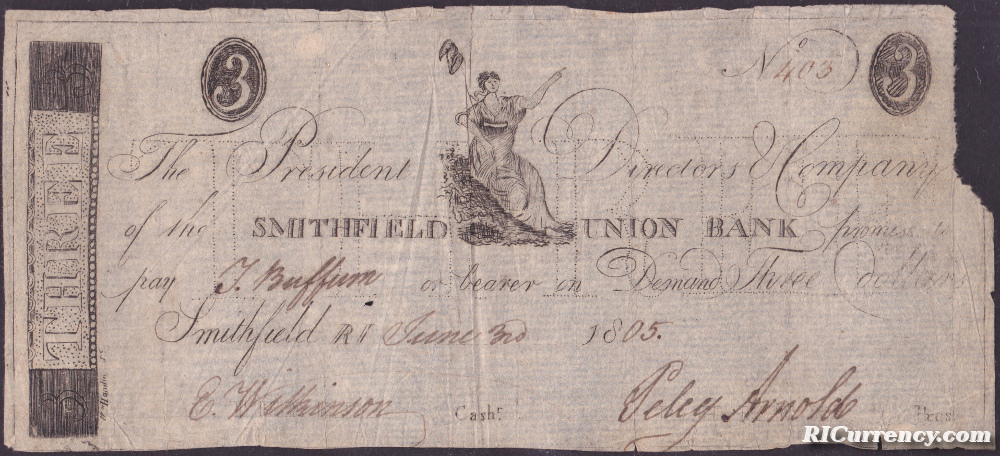
June 3, 1805. Durand 2684?, Haxby RI-475 C46, Bowers W-RI-1400-003-C120
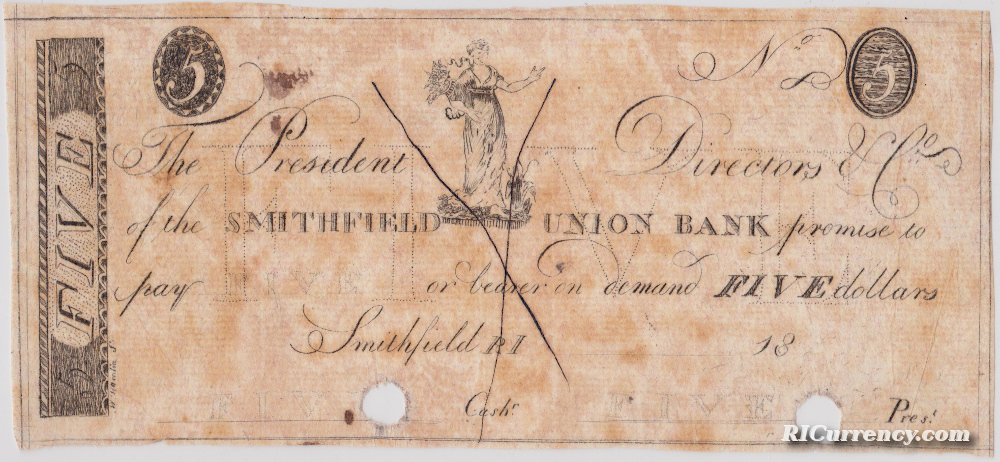
Early 1800s. Bowers W-RI-1400-005-C170
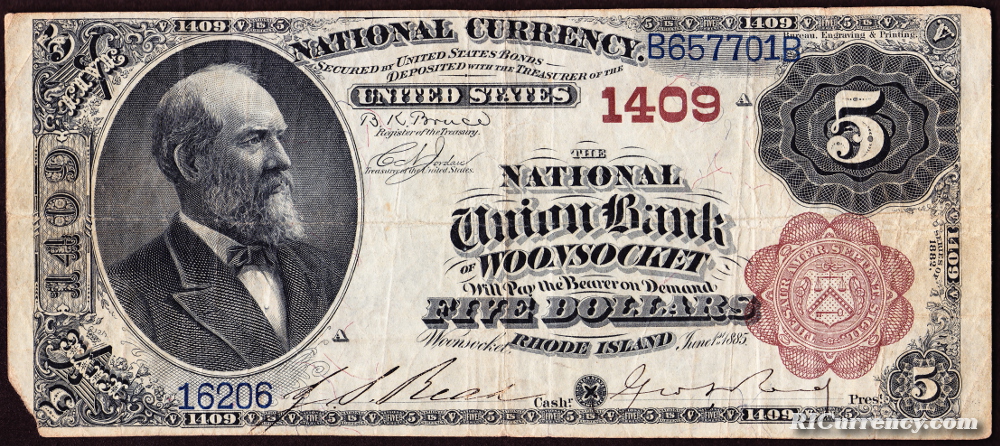
Series 1882 Second Charter Brownback. Charter #1409, Woonsocket
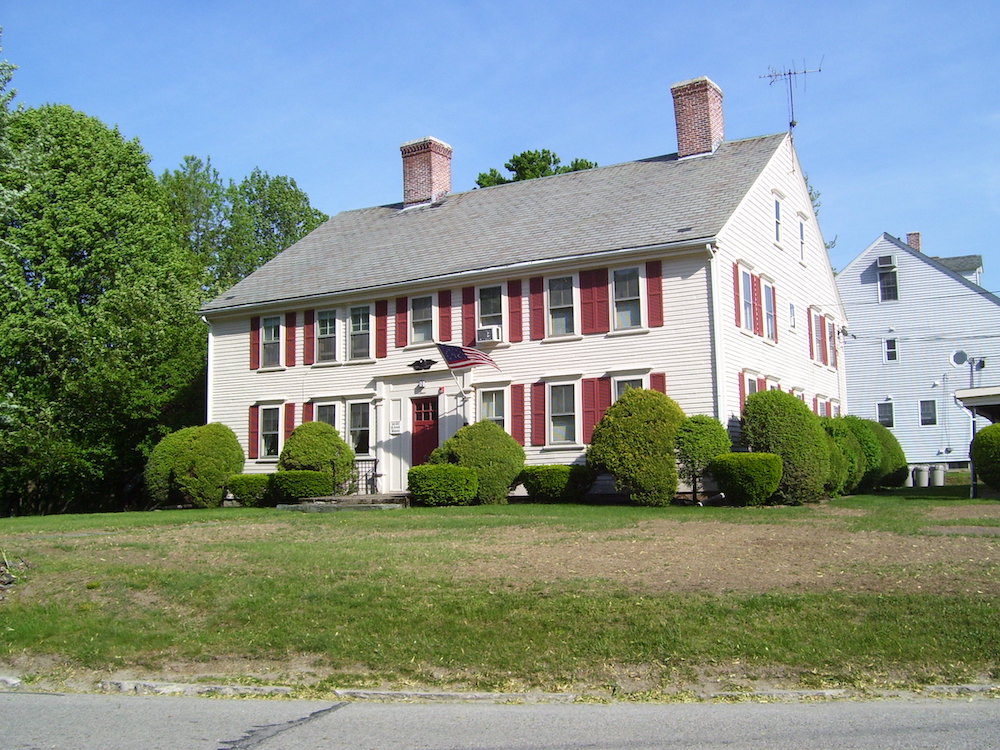
Peleg Arnold’s Tavern in Smithfield, previously a hive of Revolutionary War activity, where the bank was founded in 1805.
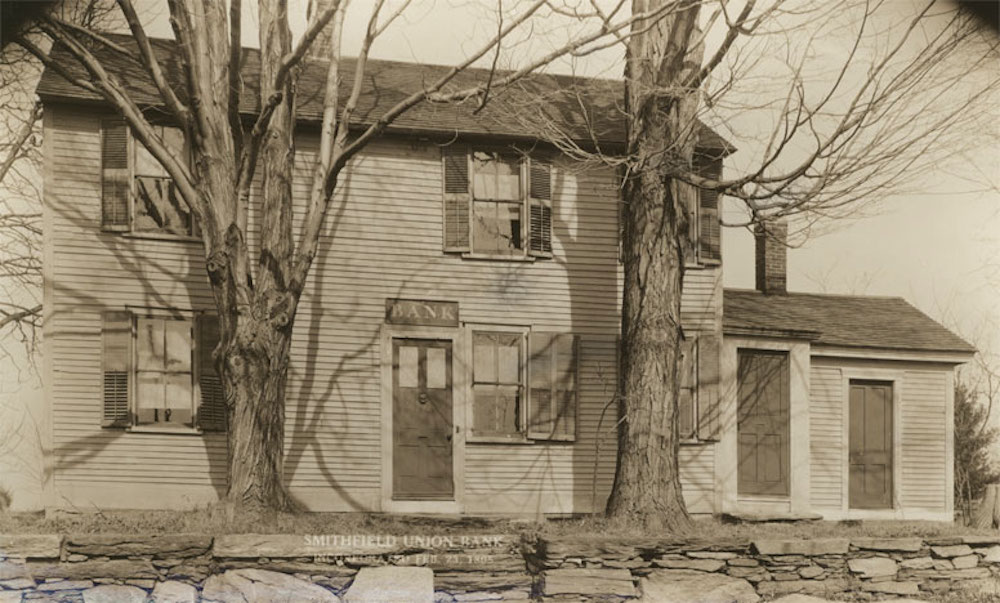
Smithfield Union Bank’s first permanent home, in Bank Village, Smithfield.
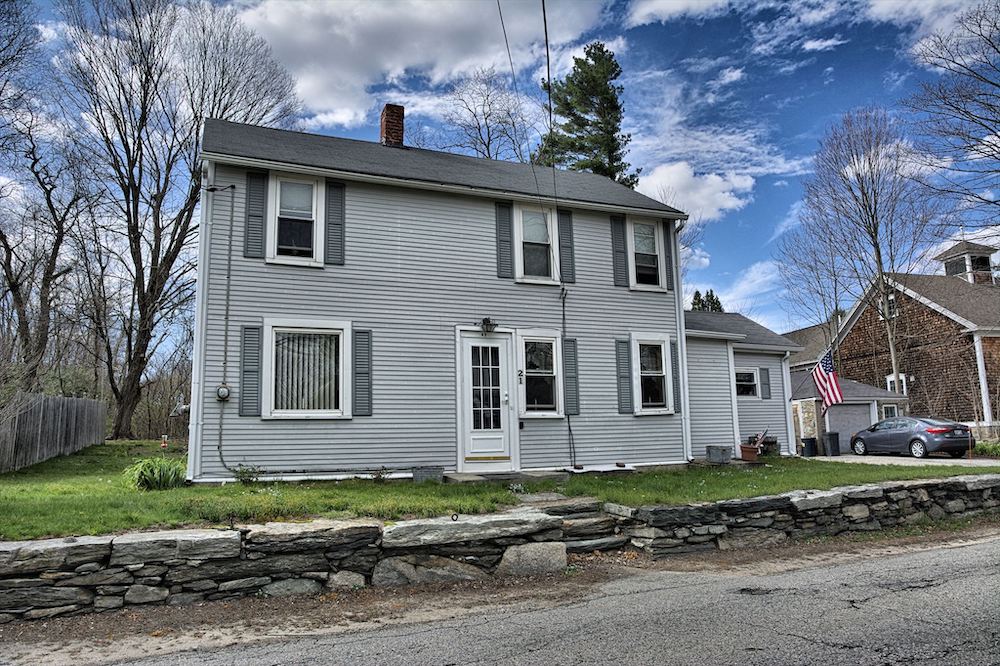
The original bank building as it appears today. About 1851, it was moved a third of a mile to its present location, now 21 Pound Hill Rd, North Smithfield, where it became a private residence.
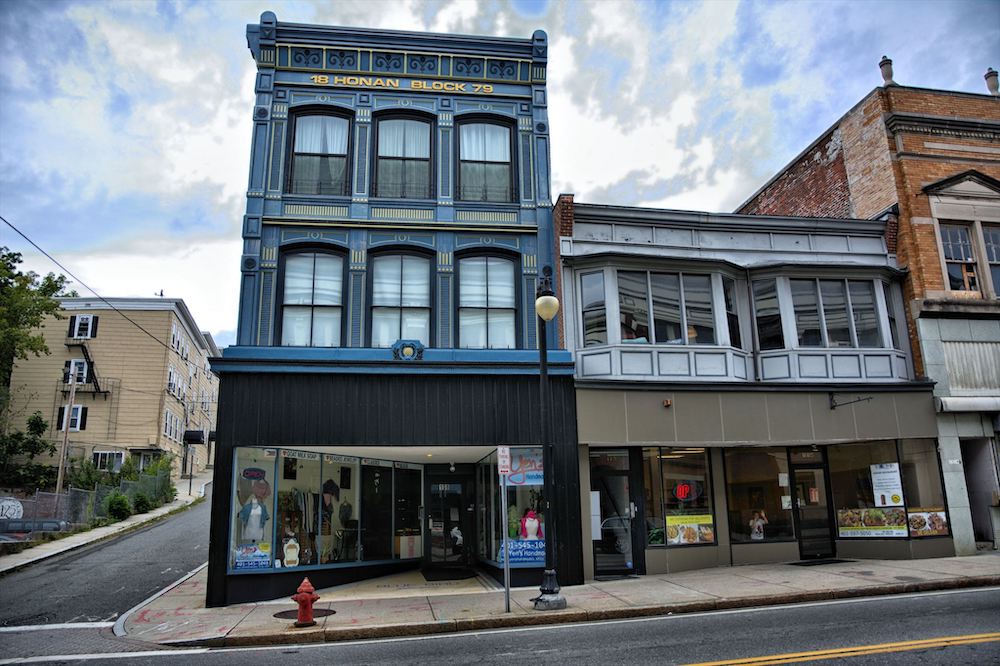
The Honan Block on Main Street in Woonsocket, which housed the National Union Bank from 1912 to 1915 and the Woonsocket Trust Company from 1912 to 1938.
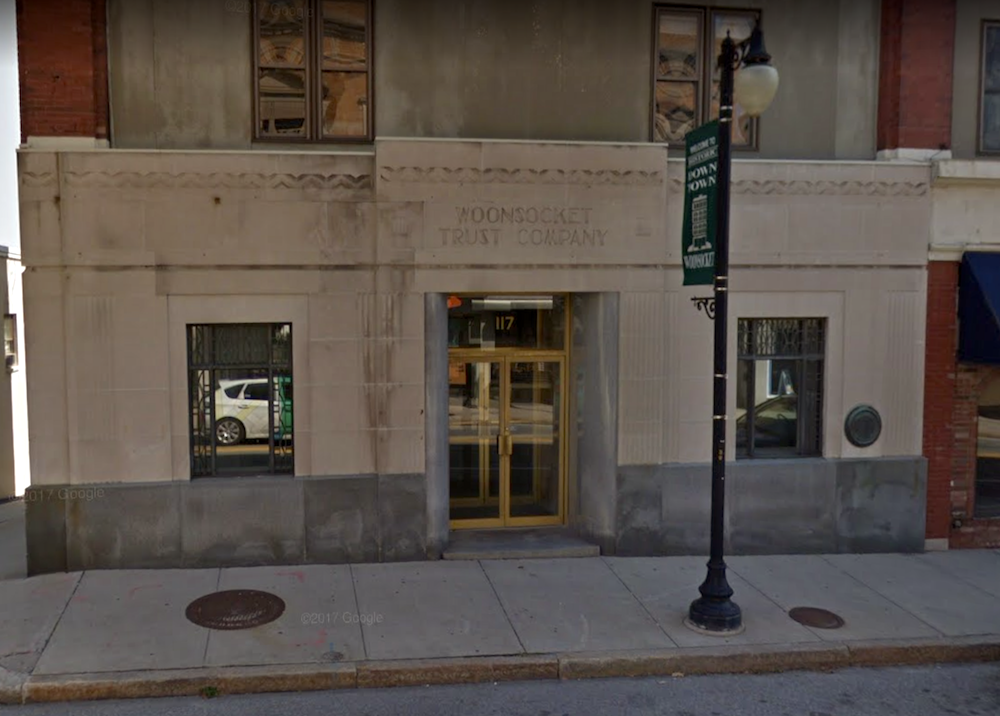
In 1938, Woonsocket Trust moved across the street to 117 Main Street in the Commercial Block.
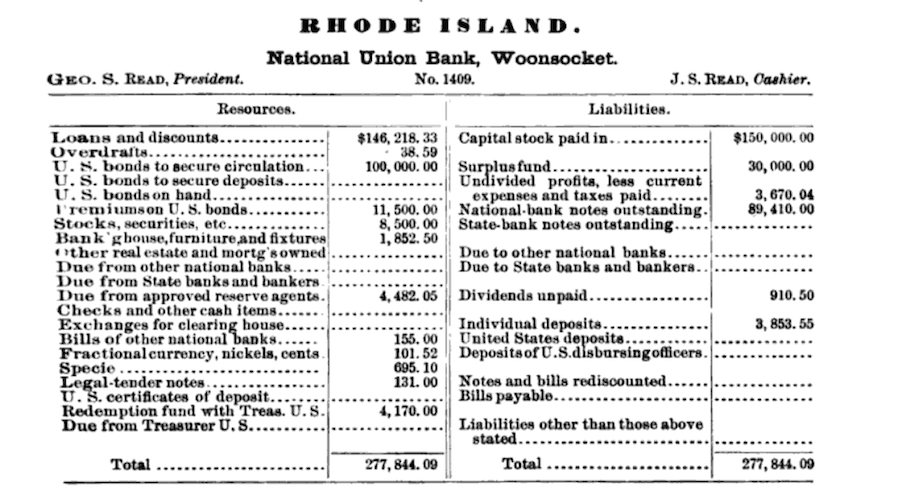
A page from the 1898 Annual Report of the Comptroller of the Currency showing the assets and liabilities of the bank.
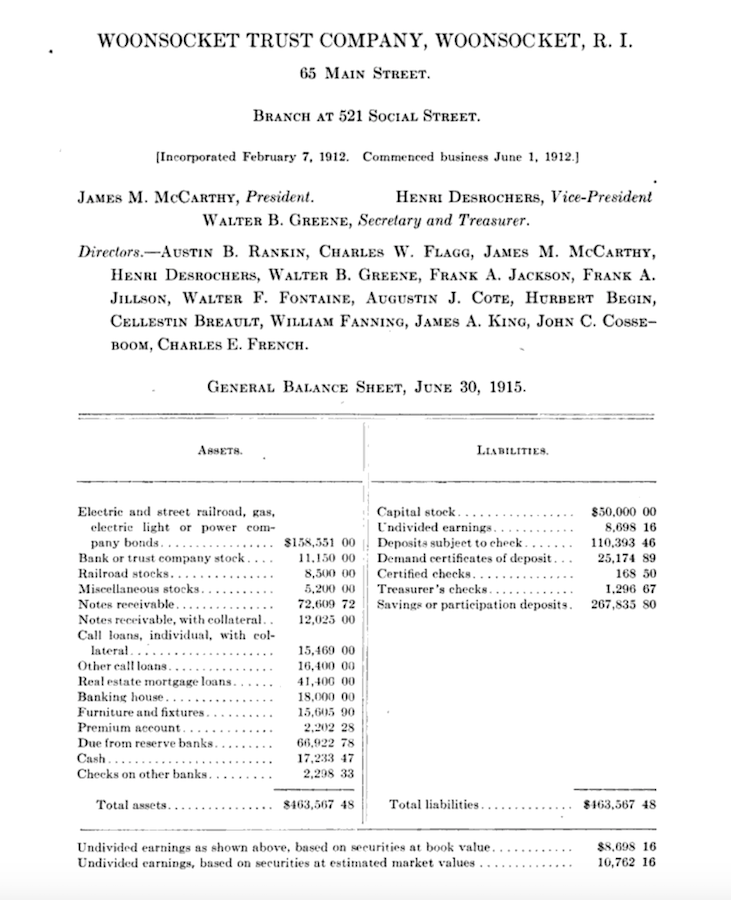
A page from a 1915 report from Rhode Island’s Bank Commissioner showing the assets and liabilities of Woonsocket Trust.
